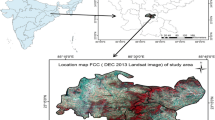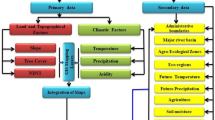Abstract
In view of climate change scenario, the increasing population, higher food demand and deteriorating land productivity are the key issues which need to be addressed in present time frame because it will be more critical in the future. The scientific evaluation of land for agroforestry is a step towards sustainability for achieving the socio-economic and environmental goal of the community. The objective of the present study was to investigate the suitability of land use/land cover of Lohardaga district of state of Jharkhand, India for agroforestry use based on FAO land suitability criteria utilizing Landsat-8 images (NDVI/wetness), ASTER DEM (elevation/slope/drainage and watershed), ancillary data source (rainfall/organic carbon/pH and nutrient status). The analysis of our study for agroforestry suitability reveals that 50.5% area as highly suitable (S1), 28.2% area as moderately suitable (S2), 20% area as marginally suitable (S3) and 1.3% area as not suitable (NS). Only 2.9% of the total land area is dominated by two season crop which is a matter of serious concern. The statistical analysis of the results reveals that the lands have huge potentiality for harnessing agroforestry crops if utilized scientifically. Such results will greatly help to the state level policymakers for achieving the national agroforestry policy goal for extending it to the new areas in the districts of Jharkhand.




Similar content being viewed by others
References
ICRAF (1993). International centre for research in agroforestry: Annual report 1993. Nairobi, Kenya, pp 208
Verchot, L. V., Van Noordwijk, M., Kandji, S., et al. (2007). Climate change: Linking adaptation and mitigation through agroforestry. Mitigation and Adaptation Strategies for Global Change, 12, 901. https://doi.org/10.1007/s11027-007-9105-6.
Nair, P. K. R. (1993). An introduction to agroforestry. Dordrecht: Kluwer.
Lipper, L., Thornton, P., Campbell, B. M., et al. (2014). Climate-smart agriculture for food security. Nature Climate Change, 4, 1068–1072.
Madusa, S. M. (2007). Role of agroforestry products in household income and poverty reduction in semi-arid areas of Misungwi District Mwanza Tanzania. Dissertation for award of Masters Degree, at Sokoine University of Agriculture. Morogoro, Tanzania.
Quli, S. M. S., Islam, M. A., & Singh, P. K. (2017). Mitigating livelihood crisis through agroforestry interventions in rural India. Jharkhand Journal of Development and Management Studies, 15(1), 7159–7178.
Islam, M. A., Rai, R., & Quli, S. M. S. (2015). Forest resources use for building livelihood resilience in ethnic communities of Jharkhand. Trends in Biosciences, 8(5), 1256–1264.
Albrecht, A., & Kandji, S. T. (2003). Carbon sequestration in tropical agroforestry systems. Agriculture, Ecosystems & Environment, 99, 15–27.
Mbow, C., van Noordwijk, M., Luedeling, E., et al. (2014). Agroforestry solutions to address food security and climate change challenges in Africa. Current Opinion in Environmental Sustainability, 6, 61–67.
Asbjornsen, H., Hernandez-Santana, V., Liebman, M., et al. (2014). Targeting perennial vegetation in agricultural landscapes for enhancing ecosystem services. Renewable Agriculture and Food Systems, 29, 101–125.
Jose, S. (2012). Agroforestry for conserving and enhancing biodiversity. Agroforestry Systems, 85, 1–8.
FAO (1976). A framework for land evaluation. Soils Bulletin 32. Food and Agriculture Organization of the United Nations, Rome, Italy. ISBN 92-5-100111-1. http://www.fao.org/docrep/t0715e/t0715e06.htm. Accessed November 10, 2017.
Clarke, K. C. (2001). Getting started with geographic information systems (3rd ed.). Upper Saddle River: Prentice Hall.
Burrough, P. A. (1986). Principles of geographic information systems for land resource assessment., Monographs on soil and resources survey No. 12 New York: Oxford Science Publications.
ESRI. (1990). Understanding GIS: The ARC/INFO method. Redlands: ESRI.
Prakash, S., Sharma, M. C., Kumar, R., et al. (2016). Mapping and assessing land degradation vulnerability in Kangra district using physical and socio-economic indicators. Spatial Information Research, 24, 733. https://doi.org/10.1007/s41324-016-0071-5.
Das, R. T., & Pal, S. (2017). Exploring geospatial changes of wetland in different hydrological paradigms using water presence frequency approach in Barind Tract of West Bengal. Spatial Information Research, 25, 467. https://doi.org/10.1007/s41324-017-0114-6.
Das, S., Gupta, A., & Ghosh, S. (2017). Exploring groundwater potential zones using MIF technique in semi-arid region: A case study of Hingoli district, Maharashtra. Spatial Information Research, 25, 749. https://doi.org/10.1007/s41324-017-0144-0.
Ahmad, F., Goparaju, L., & Qayum, A. (2018). Himalayan forest fire characterization in relation to topography, socio-economy and meteorology parameters in Arunachal Pradesh, India. Spatial Information Research. https://doi.org/10.1007/s41324-018-0175-1.
Ploton, P., Pelissier, R., Proisy, C., et al. (2012). Assessing aboveground tropical forest biomass using Google Earth canopy images. Ecological Applications, 22, 993–1003.
Bouma, J., Wagenet, R. J., Hoosbeek, M. R., & Hutson, J. L. (1993). Using expert systems and simulation modeling for land evaluation at farm level—a case study from New York State. Soil Use and Management, 9, 131–139.
Ahmad, F., & Goparaju, L. (2017). Geospatial approach for agroforestry suitability mapping: To enhance livelihood and reduce poverty, FAO based documented procedure (case study of Dumka district, Jharkhand, India). Biosciences, Biotechnology Research Asia, 14, 651–665. https://doi.org/10.13005/bbra/2491.
Ritung, S., Wahyunto, Agus F., & Hidayat, H. (2007). Land suitability evaluation with a case map of Aceh Barat District. Bogor: Indonesian Soil Research Institute and World Agroforestry Centre. ISBN 979-3198-36-1.
Reisner, Y., de Filippi, R., Herzog, F., et al. (2007). Target regions for silvoarable agroforestry in Europe. Ecological Engineering, 29, 401–418. https://doi.org/10.1016/j.ecoleng.2006.09.020.
Yedage, A. S., Gavali, R. S., & Jarag, A. P. (2013). Land assessment for horticulture (pomegranate) crop using GIS and fuzzy decision analysis in the Sangolan Taluka of Solapur District. International Journal of Remote Sensing and GIS, 2(3), 104–113.
Ahmad, F., Goparaju, L., & Qayum, A. (2017). Agroforestry suitability analysis based upon nutrient availability mapping: A GIS based suitability mapping. AIMS Agriculture and Food, 2(2), 201–220. https://doi.org/10.3934/agrfood.2017.2.201.
Ahmad, F., Goparaju, L., & Qayum, A. (2017). FAO guidelines and geospatial application for agroforestry suitability mapping: Case study of Ranchi, Jharkhand state of India. Agroforestry Systems. https://doi.org/10.1007/s10457-017-0145-y.
FSI (2001). Forest Resources of Ranchi, Gumla & Lohardaga districts of Jharkhand. http://fsi.nic.in/inventory_report/Jharkhand/Rachi,Gumla%20and%20Lohardaga%20Dist.pdf. Accessed on April 12, 2018.
Census of India (2011). http://censusindia.gov.in/2011census/dchb/DCHB_A/20/2011_PART_A_DCHB_LOHARDAGA.pdf. Accessed on April 12, 2018.
Mondal, S., Jeganathan, C., Sinha, N. K., Rajan, H., Roy, T., & Kumar, P. (2014). Extracting seasonal cropping patterns using multi-temporal vegetation indices from IRS LISS-III data in Muzaffarpur district of Bihar, India. The Egyptian Journal of Remote Sensing and Space Science, 17, 123–134. https://doi.org/10.1016/j.ejrs.2014.09.002.
Foody, G. M. (2002). Status of land cover classification accuracy assessment. Remote Sensing of Environment, 80, 185–201.
Meneses-Tovar, C. L. (2011). NDVI as indicator of degradation. http://www.fao.org/docrep/015/i2560e/i2560e07.pdf. Accessed on October 3, 2017.
Gomes, A. C. C., Bernardo, N., & Alcântara, E. (2017). Accessing the southeastern Brazil 2014 drought severity on the vegetation health by satellite image. Natural Hazards, 89, 1401. https://doi.org/10.1007/s11069-017-3029-6.
Ahmad, F., & Goparaju, L. (2017). Soil and water conservation prioritization using geospatial technology—a case study of part of Subarnarekha Basin, Jharkhand, India. AIMS Geosciences, 3(3), 375–395. https://doi.org/10.3934/geosci.2017.3.375.
Baig, M. H. A., Zhang, L., Shuai, T., & Tong, Q. (2014). Derivation of a tasselled cap transformation based on Landsat 8 at-satellite reflectance. Remote Sensing Letters, 5(5), 423–431. https://doi.org/10.1080/2150704X.2014.915434.
Bohling, G.(2005). KRIGING. http://people.ku.edu/~gbohling/cpe940/Kriging.pdf. Accessed on February 3, 2018.
Ahmad, F., & Goparaju, L. (2017). Land evaluation in terms of agroforestry suitability, an approach to improve livelihood and reduce poverty: A FAO based methodology a geospatial solution: A case study of Palamu district, Jharkhand, India. Ecological Questions, 25, 67–84. https://doi.org/10.12775/EQ.2017.006.
Bhan, S. (2013). Land degradation and integrated watershed management in India. International Soil and Water Conservation Research, 1(1), 49–57. https://doi.org/10.1016/S2095-6339(15)30049-6.
Dey, S. (2016). Jharkhand’s waterman gets Padma Shri for waging war against drought. https://www.hindustantimes.com/india/jharkhand-s-waterman-gets-padma-shri-for-waging-war-against-drought/story-7PgYljQmbDBeahSVg4gjrJ.html. Accessed on May 15, 2017.
Lal, R. (1999). Integrated watershed management in the global ecosystem. Soil and Water Conservation Society (U.S.). International Affairs Committee. Published. Boca Raton: CRC Press.
Acknowledgements
The authors are grateful to the USGS for free download of Landsat and DEM (ASTER) data which was used in the analysis.
Author information
Authors and Affiliations
Corresponding author
Ethics declarations
Conflict of interest
The authors declare that they have no competing interests.
Electronic supplementary material
Below is the link to the electronic supplementary material.
Rights and permissions
About this article
Cite this article
Ahmad, F., Uddin, M.M. & Goparaju, L. Geospatial application for agroforestry suitability mapping based on FAO guideline: case study of Lohardaga, Jharkhand State of India. Spat. Inf. Res. 26, 517–526 (2018). https://doi.org/10.1007/s41324-018-0194-y
Received:
Revised:
Accepted:
Published:
Issue Date:
DOI: https://doi.org/10.1007/s41324-018-0194-y




